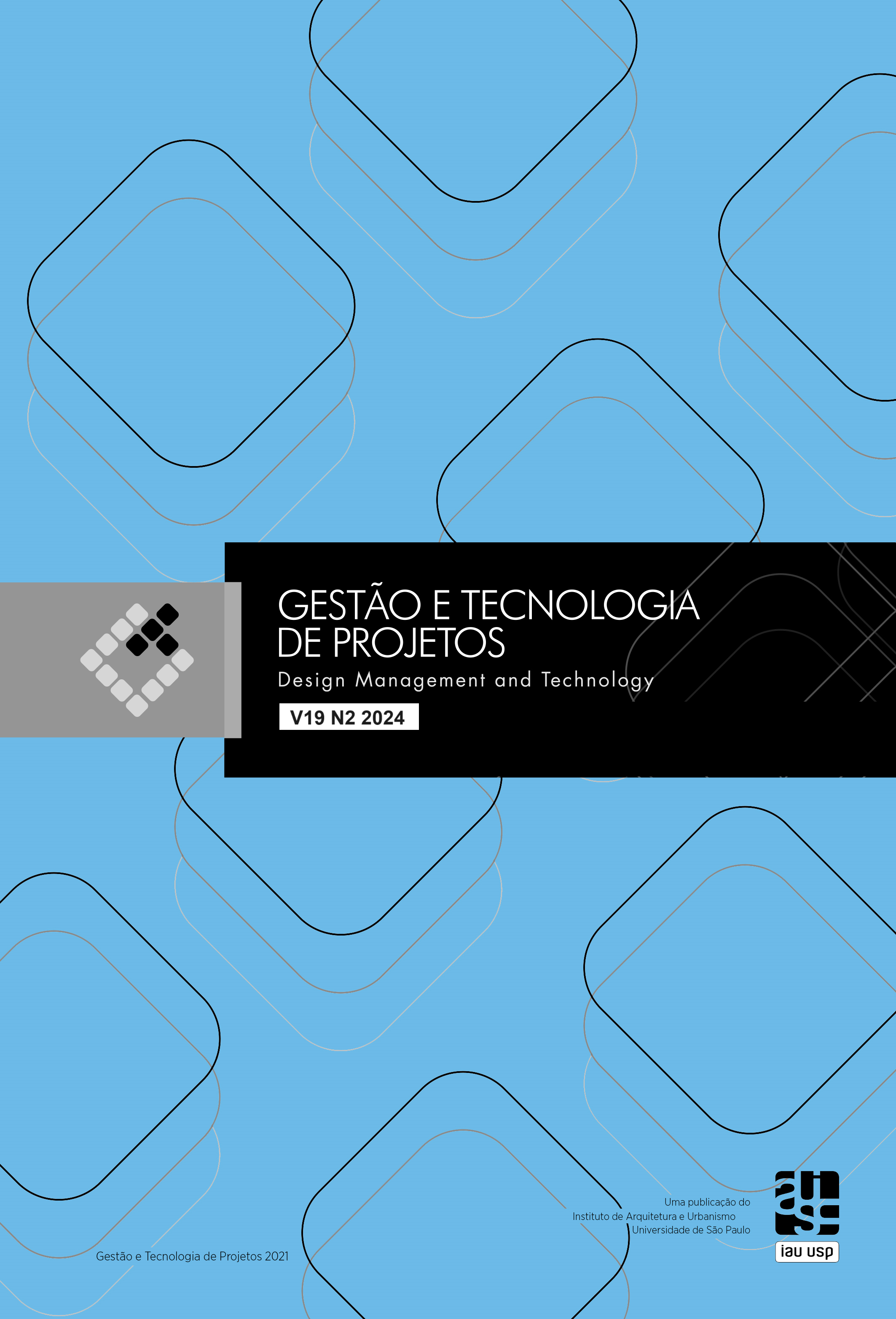Proposal of rationalization index of the construction process of mass timber structures
DOI:
https://doi.org/10.11606/gtp.v19i2.212148Keywords:
Cross-Laminated Timber , wood structures, architectural optimization, industrialized constructionAbstract
Considering the industrialized manufacturing process of mass timber structures, an issue that is constantly mentioned in the literature is the failure of communication between design and manufacturing. Consequently, there are greater material waste and a more complex and time-consuming assembly than it would be necessary. Therefore, the problem addressed in this paper is the search for optimization of CLT (Cross-Laminated Timber) and Glulam (Glued Laminated Timber) structures regarding the construction process of these technologies. The authors propose to determine indexes to quantitative measure the structural shape, as a result of the architectural shape, concerning the rationalization of the construction process. To do so, initially, the research aims to identify the variables inherent in the technology's construction process that interfere with the optimization of this process and simultaneously have a direct relationship with the architectural design. The research methodology involved the study of the construction process of the first national CLT manufacturer, as well as two case studies of structures designed, manufactured, and assembled by the same producer. Based on these studies and analysis, three indexes were defined to evaluate the manufacture and assemble process of the structures. It is considered that these should be incorporated from the beginning of the architectural conception, enabling the creation of a structural form aligned with the premises of the technology used. As future developments of this research, these indices could potentially be incorporated into a parameterized digital design tool.
Downloads
References
BIANCONI, Fabio; FILIPPUCCI, Marco; BUFFI, Alessandro. Automated design and modeling for mass-customized housing. A web-based design space catalog for timber structures. Automation in construction, v. 103, p. 13-25, 2019. Disponível em: <https://doi.org/10.1016/j.autcon.2019.03.002> Acesso em: setembro de 2022.
BRANDNER, R. Production and Technology of Cross-Laminated Timber (CLT): A state-of-the- art Report. 2013. Disponível em: <http://costfp1004.holz.wzw.tum.de/fileadmin/tu/wz/costfp1004/ Theme_I_Product_and_ Testing.pdf>. Acesso em: abril de 2017.
BRENEMAN, Scott; TIMMERS, Matt; RICHARDSON, Dennis. Tall Wood Buildings in the 2021 IBC: Up to 18 Stories of Mass Timber. WoodWorks, 2022. Disponível em: <https://www.woodworks.org/wp-content/uploads/wood_solution_paper-tall-wood.pdf> Acesso em julho de 2022.
CÔCO JÚNIOR, Verley Henry; CELANI, Gabriela. From the automated generation of layouts to fabrication with the use of BIM: a new agenda for Architecture in the 21st century. In: Proceedings of XXII Congresso Da Sociedade Iberoamericana De Gráfica Digital. Vol. 5. n. 1, p. 23-30. São Paulo: Blucher, 2018.
CONSELHO NACIONAL DE TRÂNSITO – CONTRAN. Resolução Nº 210. Brasília: Diário Oficial da União (D.O.U.), 2006.
CONSOLIDAÇÃO DAS LEIS DO TRABALHO (CLT). Decreto-Lei no 5.452 de 01/05/1943. Disponível em: <http://www.planalto.gov.br/ccivil_03/Decreto-Lei/Del5452.htm>. Acesso em setembro de 2018.
DEPARTAMENTO NACIONAL DE INFRAESTRUTURA DE TRANSPORTES (DNTI). Resolução Nº 1. Brasília: Diário Oficial da União (D.O.U.), 2016. Disponível em: <http://www.dnit.gov.br/rodovias/operacoes-rodoviarias/sistema-de-gerenciamento-de-autorizacao-especial-de-transito-siaet/RESOLUO012016DNITCargasIndivisveis.pdf>. Acesso em: setembro de 2018.
GBADAMOSI, Abdul-Quayyum; OYEDELE, Lukumon; MAHAMADU, Abdul-Majeed; KUSIMO, Habeeb; BILAL, Muhammad; DELGADO, Juan Manuel Davila; MUHAMMED-YAKUBU, Naimah. Big data for Design Options Repository: Towards a DFMA approach for offsite construction. Automation in Construction. Vol. 120. 2020. Disponível em: <https://doi.org/10.1016/j.jclepro.2019.01.113> Acesso em: setembro de 2022.
GREEN, Michael; TAGGART, Jim. Tall wood buildings: Design, construction and performance. Birkhäuser, 2020.
KRIEG, O. D.; LANG, O. Adaptive automation strategies for robotic prefabrication of parametrized mass timber building components. In: Proceedings of the 36th International Symposium on Automation and Robotics in Construction (ISARC 2019), p. 521–528. Banff, 2019.
LOTUFO OLIVEIRA, Gabriela. Cross-Laminated Timber (CLT) no Brasil: processo construtivo e desempenho. Recomendações para o processo de projeto arquitetônico. Dissertação (Mestrado em Arquitetura) - Faculdade de Arquitetura e Urbanismo da Universidade de São Paulo. São Paulo, 2018.
QI, Bing; RAZKENARI Mohamad; COSTIN, Aaron; KIBERT, Charles; FU, Meiqing. A systematic review of emerging technologies in industrialized construction. Journal of building engineering, v. 39, 2021. Disponível em: <https://doi.org/10.1016/j.jobe.2021.102265> Acesso em: setembro de 2022.
STROBLE, Kristen. (Mass) Timber: Structurally Optimized Timber Buildings. Dissertação (Mestrado em Arquitetura) - University of Washington. Seattle, 2016.
WORTMANN, Thomas; NANNICINI, Giacomo. Introduction to Architectural Design Optimization. In: KARAKITSIOU, A.; MIGDALAS, A.; RASSIA, S.; PARDALOS, P. (org). City Networks - Collaboration and Planning for Health and Sustainability. Springer International Publishing, 2017. Disponível em: <https://doi.org/10.1007/978-3-319-65338-9_14> Acesso em: setembro de 2022.
WOODWORKS, THINKWOOD. Mass Timber Design Manual. 2021. Disponível em: Acesso em: setembro de 2022.
YAZDI, Alireza Jalai; FINI, Alireza Ahmadian Fard; FORSYTHE, Perry. Mass-customisation of cross-laminated timber wall systems at early design stages. Automation in Construction. v. 132, 2021. Disponível em: <https://doi.org/10.1016/j.autcon.2021.103938> Acesso em: setembro de 2022.
Downloads
Published
Issue
Section
License
Copyright (c) 2024 Gabriela Lotufo Oliveira, Fabiana Lopes de Oliveira

This work is licensed under a Creative Commons Attribution-NonCommercial-NoDerivatives 4.0 International License.
Copyright Notice
Authors who publish in this journal agree to the following terms:
- Authors retain the copyright and grant the journal the right of first publication, with the article simultaneously licensed under the Creative Commons Attribution License BY NC ND, which allows the sharing of article with acknowledgment of authorship and initial publication in this journal.
- Authors are authorized to take additional contracts separately, for non-exclusive distribution of version of the article published in this journal (e.g. publish in institutional repository or as a book chapter), with acknowledgment of authorship and initial publication in this journal.
- Authors are allowed and encouraged to publish and distribute their research work online (e.g. in institutional repositories or on their personal page) at any point before or during the editorial process, as this can generate productive changes, as well as increase the impact and the citation of published article (See O Efeito do Acesso Livre).



